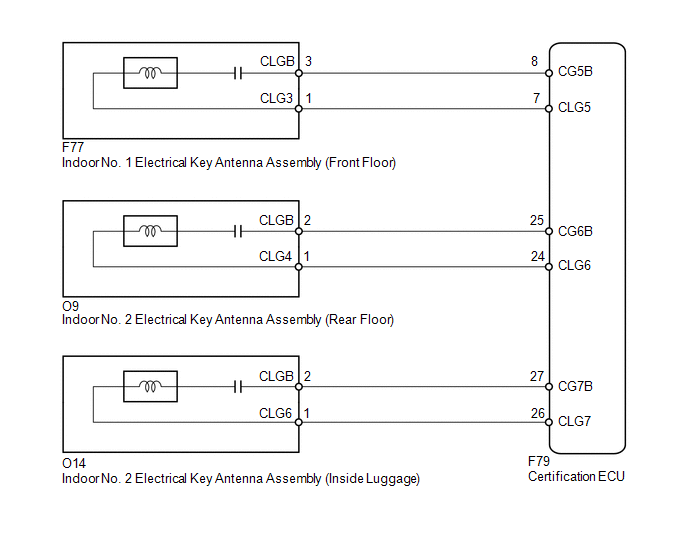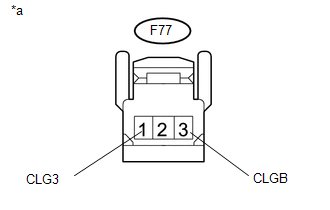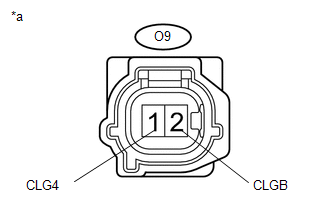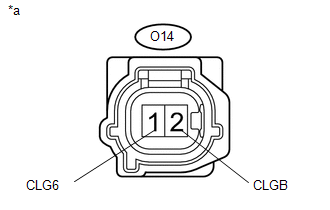Toyota 4Runner: Room Oscillator does not Recognize Key
DESCRIPTION
If the room oscillator does not recognize the key, one of the following may be the cause: 1) communication between the indoor No. 1 electrical key antenna (front floor) and electrical key transmitter cannot be performed; 2) communication between the indoor No. 2 electrical key antenna (rear floor) and electrical key transmitter cannot be performed; or 3) communication between the indoor No. 2 electrical key antenna (inside luggage) and electrical key transmitter cannot be performed.
WIRING DIAGRAM

CAUTION / NOTICE / HINT
NOTICE:
- The smart key system (for Entry Function) uses a multiplex communication
system (LIN communication system) and the CAN communication system. Inspect
the communication function by following How to Proceed with Troubleshooting
(See page
.gif) ). Troubleshoot the smart key
). Troubleshoot the smart key
system (for Entry Function) after confirming that the communication systems are functioning properly. - When using the Techstream with the engine switch off to troubleshoot: Connect the Techstream to the vehicle and turn a courtesy light switch on and off at 1.5 second intervals until communication between the Techstream and vehicle begins.
- Before replacing the certification ECU, refer to the engine immobiliser
system (w/ Smart Key System) (See page
.gif)
).
PROCEDURE
|
1. |
CHECK SMART KEY SYSTEM (START FUNCTION) |
|
(a) Remove the battery of the electrical key transmitter (See page
|
|
(b) With the brake pedal depressed, touch the TOYOTA mark of the key to the engine switch.
(c) When operating the engine switch, check whether the power source mode changes.
HINT:
- When the electrical key transmitter cannot be verified even though it is in the operating range of the start function, the engine start check can be performed by removing the transmitter battery from the electrical key transmitter and holding the transmitter against the engine switch.
- When performing the check, if the power source mode changes, there is a problem with key certification inside the cabin.
OK:
Power source mode changes.
Text in Illustration|
*1 |
Engine Switch |
|
*2 |
Electrical Key Transmitter |
| NG | .gif) |
GO TO SMART KEY SYSTEM (FOR START FUNCTION) |
|
|
2. |
CHECK WAVE ENVIRONMENT |
(a) Install the battery to the electrical key transmitter (See page
.gif) ).
).
(b) Move the electrical key transmitter as described below and perform the operation
inspection (See page .gif) ).
).
(1) Bring the electrical key transmitter near the indoor No. 1 electrical key antenna (front floor) and perform an engine control system start check.
NOTICE:
If the key is brought within 0.2 m (0.656 ft.) of the indoor No. 1 electrical key antenna (front floor), communication is not possible.
(2) Bring the electrical key transmitter near the indoor No. 2 electrical key antenna (rear floor) and perform an engine control system start check.
NOTICE:
If the key is brought within 0.2 m (0.656 ft.) of the indoor No. 2 electrical key antenna (rear floor), communication is not possible.
(3) Bring the electrical key transmitter near the indoor No. 2 electrical key antenna (inside luggage) and perform an engine control system start check.
NOTICE:
If the key is brought within 0.2 m (0.656 ft.) of the indoor No. 2 electrical key antenna (rear floor), communication is not possible.
HINT:
- When the electrical key transmitter is brought near the indoor electrical key antenna, the possibility of wave interference decreases, and it can be determined if wave interference is causing the problem symptom.
- If the inspection result is that the operation check is normal, the possibility of wave interference is high. Also, added vehicle components may cause wave interference. If installed, remove them and perform the operation check.
OK:
Engine can be started.
| OK | .gif) |
AFFECTED BY WAVE INTERFERENCE |
|
|
3. |
CHECK ELECTRICAL KEY ANTENNAS IN KEY DIAGNOSTIC MODE |
(a) Check the following antennas in the key diagnostic mode (See page
.gif) ).
).
(1) Check the indoor No. 1 electrical key antenna (front floor).
When the electrical key transmitter is at the inspection point, check that the wireless door lock buzzer sounds.
(2) Check the indoor No. 2 electrical key antenna (rear floor).
When the electrical key transmitter is at the inspection point, check that the wireless door lock buzzer sounds.
(3) Check the indoor No. 2 electrical key antenna (inside luggage).
When the electrical key transmitter is at the inspection point, check that the wireless door lock buzzer sounds.
HINT:
- If the buzzer sounds, it can be determined that the vehicle interior transmitters are operating normally.
- It is possible to check which indoor electrical key antenna (front floor, rear floor or inside luggage) is operating by the sounding of the buzzer.
- If the buzzer does not sound for any indoor electrical key antennas, the certification ECU circuit may have a malfunction.
OK:
Wireless door lock buzzer sounds.
Result|
Result |
Proceed to |
|---|---|
|
Front operation check fails |
A |
|
Rear operation check fails |
B |
|
Luggage operation check fails |
C |
|
Front, rear and luggage operation checks are normal |
D |
| B | .gif) |
GO TO STEP 8 |
| C | .gif) |
GO TO STEP 12 |
| D | .gif) |
REPLACE CERTIFICATION ECU |
|
|
4. |
CHECK HARNESS AND CONNECTOR (INDOOR NO. 1 ELECTRICAL KEY ANTENNA - CERTIFICATION ECU) |
(a) Disconnect the F77 antenna connector.
(b) Disconnect the F79 ECU connector.
(c) Measure the resistance according to the value(s) in the table below.
Standard Resistance:
|
Tester Connection |
Condition |
Specified Condition |
|---|---|---|
|
F77-1 (CLG3) - F79-7 (CLG5) |
Always |
Below 1 Ω |
|
F77-3 (CLGB) - F79-8 (CG5B) |
Always |
Below 1 Ω |
|
F77-1 (CLG3) - Body ground |
Always |
10 kΩ or higher |
|
F77-3 (CLGB) - Body ground |
Always |
10 kΩ or higher |
| NG | .gif) |
REPAIR OR REPLACE HARNESS OR CONNECTOR |
|
|
5. |
CHECK CERTIFICATION ECU |
|
(a) Disconnect the F77 antenna connector. |
|
(b) Measure the voltage according to the value(s) in the table below.
OK:
|
Tester Connection |
Switch Condition |
Specified Condition |
|---|---|---|
|
F77-1 (CLG3) - F77-3 (CLGB) |
Engine switch off, all doors closed, key not in cabin and lock sensor off → on |
No pulse generation → pulse generation |
|
*a |
Front view of wire harness connector (to Indoor No. 1 Electrical Key Antenna [Front Floor]) |
| NG | .gif) |
REPLACE CERTIFICATION ECU |
|
|
6. |
REPLACE INDOOR NO. 1 ELECTRICAL KEY ANTENNA ASSEMBLY (FRONT FLOOR) |
(a) Temporarily replace the indoor No. 1 electrical key antenna (front floor)
with a new or normally functioning one (See page
.gif) ).
).
|
|
7. |
CHECK ELECTRICAL KEY ANTENNA IN KEY DIAGNOSTIC MODE |
(a) Check the following antenna in the key diagnostic mode (See page
.gif) ).
).
(1) Check the indoor No. 1 electrical key antenna (front floor).
When the electrical key transmitter is at the inspection point, check that the wireless door lock buzzer sounds.
OK:
Wireless door lock buzzer sounds.
| OK | .gif) |
END (INDOOR NO. 1 ELECTRICAL KEY ANTENNA ASSEMBLY IS DEFECTIVE) |
| NG | .gif) |
REPLACE CERTIFICATION ECU |
|
8. |
CHECK HARNESS AND CONNECTOR (INDOOR NO. 2 ELECTRICAL KEY ANTENNA - CERTIFICATION ECU) |
(a) Disconnect the O9 antenna connector.
(b) Disconnect the F79 ECU connector.
(c) Measure the resistance according to the value(s) in the table below.
Standard Resistance:
|
Tester Connection |
Condition |
Specified Condition |
|---|---|---|
|
O9-1 (CLG4) - F79-24 (CLG6) |
Always |
Below 1 Ω |
|
O9-2 (CLGB) - F79-25 (CG6B) |
Always |
Below 1 Ω |
|
O9-1 (CLG4) - Body ground |
Always |
10 kΩ or higher |
|
O9-2 (CLGB) - Body ground |
Always |
10 kΩ or higher |
| NG | .gif) |
REPAIR OR REPLACE HARNESS OR CONNECTOR |
|
|
9. |
CHECK CERTIFICATION ECU |
|
(a) Disconnect the O9 antenna connector. |
|
(b) Measure the voltage according to the value(s) in the table below.
OK:
|
Tester Connection |
Switch Condition |
Specified Condition |
|---|---|---|
|
O9-1 (CLG4) - O9-2 (CLGB) |
Engine switch off, all doors closed, key not in cabin and lock sensor off → on |
No pulse generation → pulse generation |
|
*a |
Front view of wire harness connector (to Indoor No. 2 Electrical Key Antenna [Rear Floor]) |
| NG | .gif) |
REPLACE CERTIFICATION ECU |
|
|
10. |
REPLACE INDOOR NO. 2 ELECTRICAL KEY ANTENNA ASSEMBLY (REAR FLOOR) |
(a) Temporarily replace the indoor No. 2 electrical key antenna (rear floor)
with a new or normally functioning one (See page
.gif) ).
).
|
|
11. |
CHECK ELECTRICAL KEY ANTENNA IN KEY DIAGNOSTIC MODE |
(a) Check the following antenna in the key diagnostic mode (See page
.gif) ).
).
(1) Check the indoor No. 2 electrical key antenna (rear floor).
When the electrical key transmitter is at the inspection point, check that the wireless door lock buzzer sounds.
OK:
Wireless door lock buzzer sounds.
| OK | .gif) |
END (INDOOR NO. 2 ELECTRICAL KEY ANTENNA ASSEMBLY IS DEFECTIVE) |
| NG | .gif) |
REPLACE CERTIFICATION ECU |
|
12. |
CHECK HARNESS AND CONNECTOR (INDOOR NO. 2 ELECTRICAL KEY ANTENNA - CERTIFICATION ECU) |
(a) Disconnect the O14 antenna connector.
(b) Disconnect the F79 ECU connector.
(c) Measure the resistance according to the value(s) in the table below.
Standard Resistance:
|
Tester Connection |
Condition |
Specified Condition |
|---|---|---|
|
O14-1 (CLG6) - F79-26 (CLG7) |
Always |
Below 1 Ω |
|
O14-2 (CLGB) - F79-27 (CG7B) |
Always |
Below 1 Ω |
|
O14-1 (CLG6) - Body ground |
Always |
10 kΩ or higher |
|
O14-2 (CLGB) - Body ground |
Always |
10 kΩ or higher |
| NG | .gif) |
REPAIR OR REPLACE HARNESS OR CONNECTOR |
|
|
13. |
CHECK CERTIFICATION ECU |
|
(a) Disconnect the O14 antenna connector. |
|
(b) Measure the voltage according to the value(s) in the table below.
OK:
|
Tester Connection |
Switch Condition |
Specified Condition |
|---|---|---|
|
O14-1 (CLG6) - O14-2 (CLGB) |
Engine switch off, all doors closed, key not in cabin and lock sensor off → on |
No pulse generation → pulse generation |
|
*a |
Front view of wire harness connector (to Indoor No. 2 Electrical Key Antenna [Inside Luggage]) |
| NG | .gif) |
REPLACE CERTIFICATION ECU |
|
|
14. |
REPLACE INDOOR NO. 2 ELECTRICAL KEY ANTENNA ASSEMBLY (INSIDE LUGGAGE) |
(a) Temporarily replace the indoor No. 2 electrical key antenna (inside luggage)
with a new or normally functioning one (See page
.gif) ).
).
|
|
15. |
CHECK ELECTRICAL KEY ANTENNA IN KEY DIAGNOSTIC MODE |
(a) Check the following antenna in the key diagnostic mode (See page
.gif) ).
).
(1) Check the indoor No. 2 electrical key antenna (inside luggage).
When the electrical key transmitter is at the inspection point, check that the wireless door lock buzzer sounds.
OK:
Wireless door lock buzzer sounds.
| OK | .gif) |
END (INDOOR NO. 2 ELECTRICAL KEY ANTENNA ASSEMBLY IS DEFECTIVE) |
| NG | .gif) |
REPLACE CERTIFICATION ECU |
 Entry Interior Alarm does not Sound
Entry Interior Alarm does not Sound
DESCRIPTION
The smart key system uses the combination meter buzzer to perform various vehicle
interior warnings. When the conditions of each warning are met, the certification
ECU sends a buzzer ...
 Back Door Entry Lock and Unlock Functions do not Operate
Back Door Entry Lock and Unlock Functions do not Operate
DESCRIPTION
When the back door entry lock and unlock functions do not operate, one of the
following may be malfunctioning: 1) the power door lock control system, 2) the electrical
key antenna (ou ...
Other materials about Toyota 4Runner:
Green And Red Indicators Blink Simultaneously
DESCRIPTION
After the ignition switch is turned to ON, the DCM (Telematics Transceiver) will
enter a self check mode. The manual (SOS) switch red indicator will illuminate for
2 seconds and turn off followed by the manual (SOS) switch green indicator illu ...
Disposal
DISPOSAL
CAUTION / NOTICE / HINT
CAUTION:
Before performing pre-disposal deployment of any SRS part, review and closely
follow all applicable environmental and hazardous material regulations. Pre-disposal
deployment may be considered hazardous material ...
0.0259

.png)
.gif)


